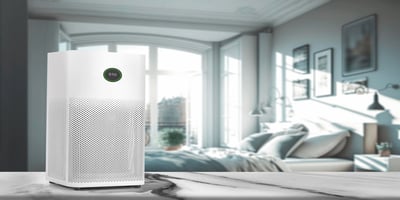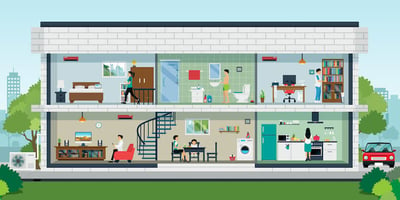How Long Does it Take an Air Purifier to Clean a Room?
Key Takeaways
- You'll notice fresher air in 20-30 minutes, though full purification takes anywhere from 45 minutes to over 2 hours based on conditions
- CADR (Clean Air Delivery Rate) matters most when choosing a purifier—aim for a number that's at least two-thirds of your room's square footage
- Fine particles like smoke need more time to clear than larger ones like pollen or dust
- Where you place your purifier changes everything: keep it at least 3 feet away from walls and furniture
Dirty filters cut efficiency in half—regular maintenance isn't optional
Indoor air quality affects your health more than most people realize. Air purifiers tackle common pollutants: dust, pollen, smoke, pet dander, and mold spores, transforming stuffy spaces into cleaner, healthier environments. If you have asthma, allergies, or other respiratory issues, this isn't just about comfort. It's about breathing easier every day. But here's what everyone wants to know: how long does an air purifier actually need to clean a room? The answer varies based on your room's size, your purifier's capabilities, and how polluted the air is when you start. Once you understand what influences these timelines, you can get much better results.
Factors That Affect Purification Time
Room Size
Bigger rooms mean more air to filter. That's just physics. Air purifiers come with ratings that tell you the maximum room size they can handle effectively. Use a unit that's too small, and you'll wait longer for results, or never quite get the air as clean as you'd like.
A compact unit works fine for small bedrooms and home offices under 200 square feet. Medium-sized rooms like master bedrooms or living rooms (200-400 sq ft) need something more powerful. Large, open spaces over 400 square feet? You'll need a high-capacity model, or possibly multiple units placed strategically.
Here's what happens with a mismatch: put a purifier designed for 200 square feet into a 400-square-foot room, and it won't stop working. But it'll take roughly twice as long to get similar results, and you're working the machine harder than it was designed for.
CADR (Clean Air Delivery Rate)
CADR tells you how much filtered air comes out of your purifier each minute. Think of it as the engine size—more CADR means faster cleaning and better overall performance.
The rating is tested separately for three types of particles: smoke, dust, and pollen. Higher numbers are always better. When you're shopping, look for a CADR that's at least two-thirds of your room size in square feet. So a 300-square-foot room needs a CADR around 200 or higher. Units with higher CADR ratings cycle air faster and maintain cleaner conditions throughout the day.
Pollutant Types Load
Not all pollutants are created equal. What's floating in your air, and how much of it, directly impacts how long cleaning takes.
Large particles like pollen and pet dander get captured pretty quickly, usually in 30-45 minutes. Dust and mold spores fall somewhere in the middle. The real challenge comes with tiny particles: smoke, bacteria, viruses. These require extended run times because they're harder to trap. Odors and gases need activated carbon filters and can take several hours to fully eliminate.
Starting with heavy pollution makes a difference too. Cooking something smoky or dealing with wildfire season means longer run times compared to just maintaining air that's already reasonably clean.
ACH (Air Changes Per Hour)
ACH measures how many times your purifier filters all the air in a room during one hour. More air changes mean pollutants get removed faster.
Most homes do well with 4-5 air changes per hour for everyday use. People with allergies or pets should target 5-6 ACH. Severe allergies, asthma, or particularly polluted environments might need 6-12 ACH. Quality residential purifiers typically aim for 5 ACH, which means cycling your room's entire air volume five times hourly, or every 12 minutes.
Placement & Ventilation
Where you put your purifier can improve or tank its performance by 30-50%. Location matters that much.
Give your unit breathing room, at least 3 feet from walls and furniture. Position it where air naturally circulates, not jammed in a corner or tight spot. If allergies are your main concern, place it at breathing height, roughly 2-3 feet off the floor. Never block the intake vents with curtains or other fabrics.
Natural ventilation has trade-offs. Opening windows can dilute pollutants, but it also brings in whatever's floating around outside. If your outdoor air quality is good, periodic window opening actually helps. Urban areas with smog or high pollen days? Keep those windows shut and let the purifier do its job.
Estimated Times for Different Room Sizes
Here's what you can expect for purification times across different room sizes, assuming you've matched your purifier's CADR appropriately and you're starting with typical pollution levels:
|
Room Size |
ACH Rate |
Estimated Time for Significant Purification |
|
100 sq ft |
5 |
30-60 minutes |
|
200 sq ft |
5 |
30-60 minutes |
|
300 sq ft |
5 |
45-90 minutes |
|
400 sq ft |
5 |
60-120 minutes |
|
500 sq ft |
5 |
60-120 minutes |
What these numbers mean: "Significant purification" refers to removing 80-90% of airborne pollutants from normal levels. You'll notice the difference within 20-30 minutes, but reaching the purifier's full potential takes the complete time shown.
A real example: Take a 250-square-foot bedroom with a properly rated purifier (CADR around 170 or better). You'll feel the improvement in 30 minutes. Give it a full hour, and you'll hit optimal air quality under normal circumstances. Just finished frying fish? Tack on another 30-60 minutes.
 Other Influencing Factors
Other Influencing Factors
Outdoor Air Quality
Poor outdoor air creates an ongoing challenge. Urban smog, wildfire smoke, seasonal pollen, these continuously seep indoors through doors, windows, and ventilation systems. In these situations, your purifier runs constantly just to maintain acceptable air quality. It may never reach the pristine baseline possible in areas with clean outdoor air.
This constant battle means longer operating times and filters that need replacing more frequently. During severe events like wildfires or smog warnings, close your windows and run the purifier on high. Urban dwellers typically need round-the-clock operation, while rural homes might manage with intermittent use.
Continuous Pollutant Sources
Some pollution sources never stop. Your purifier has to work continuously instead of cleaning once and coasting.
Cooking releases particles and gases continuously, especially from gas stoves that emit carbon monoxide and nitrogen dioxide. Smoking or vaping indoors adds constant particulates. Pets shed dander and hair all day long. Cleaning products release VOCs during and after use. New furniture and carpets can off-gas for weeks or months after purchase.
When you have these active sources, your purifier maintains livable air quality rather than achieving a perfectly clean state. That's not a malfunction—it's the unit doing exactly what it should.
Making Your Purifier More Effective
Maintenance Best Practices
Filter replacement keeps your purifier working properly. HEPA filters generally last 12-18 months, though this varies with usage intensity and your air quality. Activated carbon filters handling odors and gases need replacement every 3-6 months. Pre-filters catch larger debris and need monthly attention.
Watch for signs that filters need changing: weaker airflow, strange noises, smells that persist despite the purifier running, or visible grime on the filters themselves. Many modern units include indicators that alert you when replacement time arrives.
Monthly maintenance should include vacuuming or washing pre-filters to preserve airflow, wiping down the exterior to prevent dust buildup, and cleaning any sensors with a soft, dry cloth every few months.
Ventilation & Behavior
Smart ventilation habits amplify your purifier's impact. Run exhaust fans when cooking, particularly if you use gas. Keep bathroom fans going during and after showers to evacuate moisture. Open windows when outdoor air quality is good to bring in fresh air, but seal them during pollen season, poor air quality days, or when wildfire smoke arrives.
Simple behavior changes reduce the pollutants your purifier has to handle. Taking shoes off at the door cuts way down on tracked-in contaminants. Regular vacuuming with a HEPA-equipped vacuum removes particles before they become airborne again. Skip smoking indoors entirely. Go easy on candles and incense. Choose paints, furniture, and cleaning products labeled as low-VOC when possible.
Complementary Methods
Other approaches can support your air purification efforts. Houseplants like snake plants, pothos, and spider plants contribute modestly to air cleaning while adding oxygen and humidity. They won't replace a mechanical purifier, but they help.
Controlling humidity matters more than most people realize. Dehumidifiers prevent mold and dust mite problems in damp climates. Humidifiers stop respiratory irritation in dry environments and keep mucous membranes healthy. Shoot for 30-50% relative humidity for comfort and air quality.
Skip synthetic air fresheners, scented candles, and plug-in fragrances. Most release VOCs that pollute your air. Use unscented products instead, or simply let your purifier neutralize odors naturally.
The best strategy? Eliminate pollution sources when you can. Fix leaks before mold develops. Address moisture problems immediately. Ensure proper ventilation throughout your home. Choose low-emission products whenever you have the option.
Smart Purification in Action
Sensibo Pure represents the next generation of home air purification. Instead of running at fixed speeds regardless of conditions, it monitors your air quality in real time and adjusts automatically.
Built-in PM2.5 sensors detect fine particles invisible to the eye. When pollution levels rise, from cooking, outdoor air coming in, or other sources—Sensibo Pure responds immediately. Smart scheduling and geofencing mean the purifier can start working before you arrive home, so you walk into fresh air rather than waiting for it to clear.
The mobile app puts complete control at your fingertips. Check real-time air quality readings from anywhere. Adjust fan speeds remotely. Set schedules that match your routine. Monitor filter life so you know exactly when replacement is needed. Integration with Amazon Alexa, Google Assistant, and Apple HomeKit adds voice control and lets you build automation routines.
Performance-wise, Sensibo Pure uses true HEPA filtration that captures 99.97% of particles down to 0.3 microns. An activated carbon filter handles odors and VOCs. The unit covers up to 174 square feet with 5 complete air changes hourly. Operation is remarkably quiet, as low as 23dB, quieter than a whisper. Energy efficiency keeps electricity costs minimal even with continuous operation.
 Your Next Steps
Your Next Steps
Most air purifiers start making a noticeable difference within 20-30 minutes. Achieving significant purification, removing 80-90% of pollutants, typically takes 45 minutes to 2 hours depending on your room size, CADR rating, pollution levels, and setup. Understanding what drives these timelines helps you choose the right equipment and use it effectively.
Success comes down to a few key practices. Match your purifier's CADR to your room size properly. Replace filters on schedule. Position the unit where air can flow freely. Combine your purifier with smart ventilation and source control strategies. Many people wonder how long to run air purifier to get optimal results. The answer for most situations is continuous operation, or at minimum 12-24 hours daily, particularly if you deal with allergies, have pets, or live in an area with air quality challenges.
Ready to breathe cleaner air? Choose a quality purifier appropriate for your space, maintain it consistently, and experience the difference healthier indoor air makes for you and your family.
Consider smart air purification systems that monitor conditions automatically and adapt to keep your home's air fresh around the clock.
FAQ
How long should I run my air purifier each day?
Running your purifier continuously or for at least 12-24 hours daily delivers the best results, especially if you have allergies, pets, or live in a polluted area. Modern units are designed for continuous operation and use minimal electricity.
Can I speed up the purification process?
Yes. Start on the highest setting for rapid initial cleaning, then drop to a lower setting for ongoing maintenance. Make sure the unit has clear space around it and keep filters clean for peak efficiency.
Do air purifiers work immediately?
You'll notice some improvement within 20-30 minutes as the first air changes complete. Reaching truly optimal air quality usually takes 45 minutes to 2 hours depending on your room size and how polluted the air was initially.
Accordion title
Units with air quality sensors show real-time feedback through lights or displays. You might also notice less dust settling on surfaces, reduced odors, easier breathing, and fewer allergy symptoms over time.
Should I use an air purifier with windows open or closed?
Generally, close windows while the purifier runs to prevent untreated outdoor air from entering. If outdoor air quality is excellent, you can open windows periodically to refresh your indoor air, though this extends the time needed for purification.
What's the difference between room coverage and actual cleaning time?
Room coverage tells you the maximum square footage a purifier can handle effectively. Cleaning time refers to how long it takes to achieve sufficient air changes per hour within that space—two related but different measurements.


































.jpg)


.jpg?height=200&name=photo_2023-11-24_20-13-54%20(1).jpg)
